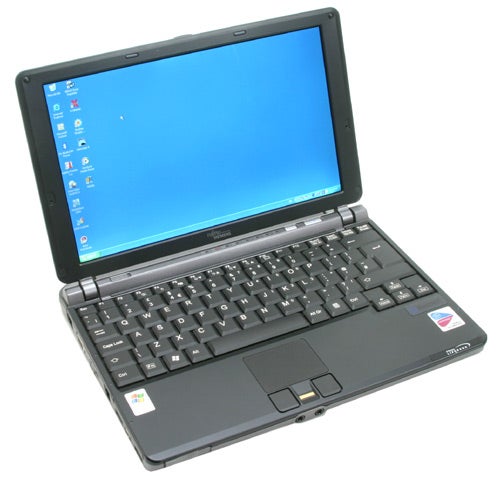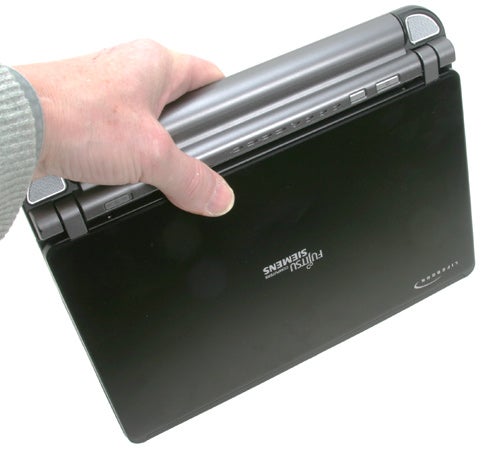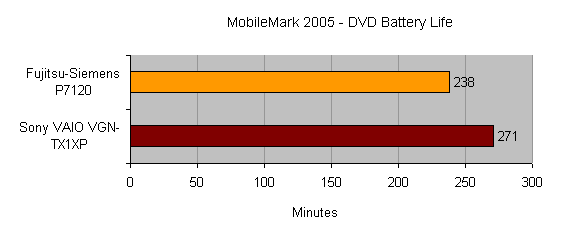Fujitsu-Siemens Lifebook P7120 Review
Fujitsu-Siemens Lifebook P7120
It's not just Sony that can make slim, light and sexy notebooks. In fact Fujitsu-Siemens even throws "quiet" into the mix.

Verdict
Key Specifications
- Review Price: £1397.00
It’s been over a year since I reviewed the Lifebook P7010 from Fujitsu-Siemens and things have moved on in leaps and bounds since then. The new model – the Lifebook P7120 – has taken the best parts of the P7010 and then had the latest in mobile technology added to it. Sure, it’s not dual core – although I would expect a Core Duo version later this year, but nothing has been announced as yet – but this is one of the thinnest and lightest notebooks out there that still offers a built in optical drive.

The Lifebook P7120 is no powerhouse by any means, but it is more than powerful enough for everyday office tasks, Internet access and general multimedia usage. The processor is an ultra low voltage Pentium M 753 which is clocked at a comparably slow 1.2GHz. However, the ULV processor means that you get less heat and longer battery life. Interestingly, the Lifebook P7120 is passively cooled; there isn’t a single fan inside it. This makes it the quietest notebook I have ever had the pleasure to review.
The only audible noise that comes from the Lifebook P7120 is from the 60GB Toshiba 1.8in hard drive, but you have to put your ear quite close to the notebook to hear this. Slightly disappointing is the fact that the P7120 only ships with 512MB of memory, the same as the P7010. However, there is a spare slot that can accept another 512MB module, so you could upgrade the memory quite easily later on.

The optical drive is manufactured by Matsushita and writes to DVD+/-R media at 4x, DVD+RW at 2.4x, DVD-RW at 2x, DVD+R DL at 2.4x and finally DVD-RAM at 3x. It will also write to CD-R discs at 24x and CD-RW at 16x. This is one of the strong points of the Lifebook P series and has been as long as I can remember, since many slim line notebooks like this comes with an external drive. As the drive is removable you can add a second battery here – which is about £117.50 inc VAT – instead of the drive, which would increase the battery life considerably.
The ports have changed slightly as well, with the CF card slot missing altogether. This might not be an issue to most users as you can use an adapter and fit any CompactFlash card in the PC Card slot. On the left side are two USB 2.0 ports with a four-pin FireWire port in between them, the modem connector, an S-Video out, a D-SUB and finally an RJ-45 port for the onboard 10/100Mbit Ethernet. There are no connectors around the back, as this is taken up by the battery, but the speakers are located here, one on each side of the battery.

The right hand side houses the optical drive, the power connector, a third USB 2.0 port and a multi format card reader – this will accept MMC, SD, xD and MemoryStick cards and their various smaller formats with suitable adaptors. On the front is a headphone and microphone socket – the headphone socket also doubles as optical S/PDIF output. A port replicator is also available as a cost option for about £58.
The connectivity options don’t stop here and it would have been disappointing if they had. The Centrino sticker is a dead giveaway of the fact that the Lifebook P7120 has built in WiFi. The Intel PRO/Wireless 2915a/b/g card supports all three wireless standards, which are 802.11a/b/g. This should allow you to connect to just about any wireless network in the world.

On top of this Fujitsu-Siemens has also managed to squeeze in Bluetooth 1.2, which allows you to connect your mobile phone or PDA to the Lifebook P7120 wirelessly. The only thing missing is IrDA but this is a dying standard as more and more devices support Bluetooth.
Fujitsu-Siemens has always been big on security features and the Lifebook P7120 is no exception. Between the touchpad buttons hides a small finger print reader. This is of the swipe type and seems to be the preferred finger print reader on the latest generation of notebooks – as seen on Lenovo ThinkPads also.

The display has kept size to a minimum but resolution is still high enough to be useful – there screen measures 10.6in and has a widescreen resolution of 1,280 x 768. The screen features a high contrast glossy coating and uses an LED backlight. The LED backlight has advantage and disadvantages, with the advantage being lower power drain which equals better battery life. The downside is that there is some light bleed and the bottom corners of the screen were quite dark on the review model.
The display is powered by the integrated graphics in the Intel 915GMS chipset, which shares around 8MB of system memory. Not the most powerful graphics chipset, but then again, you wouldn’t get the Lifebook P7120 if you wanted to play games. The advantage of having integrated graphics is that there is less power draw – today’s discrete mobile graphics solutions can often be the most power hungry part of a notebook.

They keyboard is generally very good to type on, but due to the size of the Lifebook P7120 this is of course smaller than a normal keyboard. It is still very usable, although the Function keys are tiny. The layout is otherwise good and most keys are were you would expect them to be. The touchpad is again small, but very accurate and responsive. For those that use the built in microphone on a notebook the P7120 offers stereo recording as it has a microphone on each side of the screen.
Just below the screen is a hard switch that enables and disables the wireless network antenna as well as set of LEDs that indicate battery status and hard drive activity. This is also where the power button is located alongside an EcoButton that powers off certain parts of the notebook – such as the PC Card slot and the FireWire port – to further enhance the battery life.

For larger corporate businesses the Lifebook P7120 also features a TPM (Trusted Platform Module), which allows for added security for VPN authentication among its uses.
Without the optical drive fitted the Lifebook P7120 weighs in at 1.28kg, but fitting the drive brings this up to about 1.48kg. It measures 271 x 209.5 x 28.3mm (WxDxH) which is thinner but slightly wider and deeper than the P7010.
Performance wise the Lifebook P7120 is no scorcher, but it compares well to similar machines. However, the Sony Vaio TX1XP offered about the same performance and had longer battery life, but at a higher price. Still, with seven minutes short of five hours battery life in MobileMark 2005 it’s hard to complain and the DVD playback test was two minutes short of four hours.

This doesn’t mean that the Lifebook P7120 is a bad notebook by any means as there are few that can touch it in terms of battery life in its class. Considering that you can pick ono up for £1,397.08 this is a pretty good value proposition for anyone that needs an ultra portable machine with a built in drive. Fujitsu-Siemens has once again shown that the Lifebook P family of ultra portable notebooks is one of the best models out there.
”’Verdict”’
The Lifebook P7120 is yet another excellent ultra portable machine from Fujitsu-Siemens which offers a wide range of features, good battery life and considering its size a very attractive price.





How we test laptops
Unlike other sites, we test every laptop we review thoroughly over an extended period of time. We use industry standard tests to compare features properly. We’ll always tell you what we find. We never, ever, accept money to review a product.
Trusted Score
Score in detail
-
Performance 8
-
Value 8
-
Features 9

